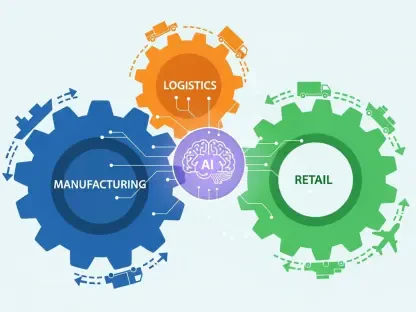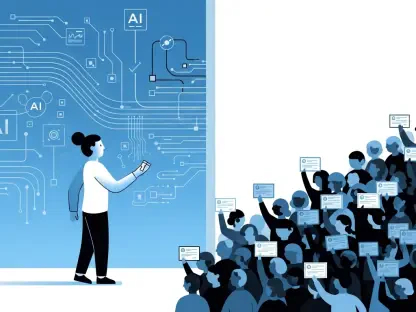In an era where digital landscapes are expanding at breakneck speed, the realm of cybersecurity faces challenges that are as complex as they are relentless, demanding innovative solutions that blend technology with human expertise. As Cybersecurity Awareness Month prompts reflection on the state of digital protection, it becomes evident that traditional defenses like firewalls and basic training are no longer sufficient against the sophisticated threats emerging daily. Artificial intelligence (AI) has surged to the forefront of this battle, reshaping both the nature of cyberattacks and the strategies to counter them. This powerful technology, while a boon for automating threat detection and enhancing security measures, also equips adversaries with tools to craft intricate deceptions. Yet, amidst this technological tug-of-war, human insight remains a critical component, offering creativity and ethical judgment that machines cannot replicate. The synergy of AI and human expertise is forging a new frontier in cybersecurity, one that extends beyond mere awareness to proactive, adaptive resilience. This exploration delves into how these two forces are combining to protect an increasingly interconnected world, addressing vulnerabilities from supply chains to everyday digital interactions. It’s a pivotal moment to examine how this partnership is not just responding to threats but redefining the very approach to digital safety, ensuring that innovation and protection go hand in hand in an ever-evolving landscape of risk.
AI: A Tool for Both Attackers and Defenders
The transformative impact of AI on cybersecurity cannot be overstated, as it serves as a double-edged sword that both empowers attackers and strengthens defenders in unprecedented ways. Cybercriminals are leveraging AI to orchestrate highly sophisticated social engineering schemes, including phishing campaigns, deepfake videos, and voice-cloning scams that deceive even the most cautious individuals. These AI-driven tactics exploit human trust with alarming precision, often evading traditional detection tools like secure email gateways. Industry reports highlight a dramatic surge in such attacks, underscoring how technology can be weaponized to manipulate perceptions and breach defenses. The ability of AI to mimic human behavior or generate convincing content has elevated the stakes, making it imperative for security measures to evolve at a matching pace. This dark side of AI reveals a pressing need for systems that can anticipate and counteract these advanced manipulations before they cause irreparable harm.
Conversely, AI offers a lifeline to cybersecurity professionals by revolutionizing defensive capabilities with speed and efficiency that human efforts alone cannot achieve. Through machine learning algorithms, AI systems can analyze vast datasets to detect anomalies, predict potential threats, and automate responses to incidents in real time. The concept of the “bionic hacker” has gained traction, where security researchers use AI tools to amplify their skills, enabling faster identification of vulnerabilities and exploration of complex attack surfaces. This partnership allows for a proactive stance, where threats are not just reacted to but anticipated through pattern recognition and behavioral analysis. Such advancements are crucial in a landscape where the volume and complexity of attacks continue to grow, providing a scalable solution to monitor and protect sprawling digital environments. The integration of AI into defense strategies marks a significant shift, ensuring that technology serves as an enhancer of human expertise rather than a standalone fix.
The Escalating Complexity of Cyber Threats
Modern cyber threats have evolved into intricate, multifaceted assaults that exploit the interconnected nature of today’s digital ecosystems with devastating effect. Attackers now employ coordinated strategies that blend various channels, such as phishing emails laced with deepfake media or smishing attempts paired with synthetic voice messages, to manipulate human behavior. These methods capitalize on psychological vulnerabilities, often bypassing outdated security protocols that fail to recognize such nuanced deceptions. The sophistication of these attacks means that a single lapse in judgment can open the door to significant breaches, affecting not just individuals but entire organizations. This growing complexity demands a reevaluation of how threats are perceived and countered, pushing beyond reactive measures to a more anticipatory approach that can match the cunning of adversaries.
A particularly alarming trend is the rise of supply chain attacks, where a breach in one organization cascades through interconnected networks, impacting multiple industries. Recent incidents across sectors like aviation, retail, and manufacturing in Europe illustrate how a single weak link can trigger widespread disruption, akin to a row of dominoes falling in quick succession. Such vulnerabilities highlight the systemic risks embedded in global business ecosystems, where trust between partners can be exploited to devastating effect. Addressing these threats requires not only technological upgrades but also a cultural shift toward shared vigilance and accountability. Organizations must recognize that cybersecurity is no longer an isolated concern but a collective responsibility that spans beyond their immediate boundaries, necessitating robust collaboration to safeguard against these far-reaching consequences.
Outgrowing Traditional Cybersecurity Models
The limitations of traditional cybersecurity frameworks are becoming increasingly apparent as they struggle to keep pace with the rapid evolution of digital threats. Conventional tools like malware scanners and basic email filters are often outmatched by AI-generated attacks that mimic legitimate communications or exploit human error with startling accuracy. Statistics reveal that a significant majority of breaches still originate from human oversight, pointing to a persistent gap in defenses that outdated awareness programs fail to address. These shortcomings expose a critical flaw: relying on static solutions in a dynamic threat landscape leaves organizations vulnerable to exploitation. The time has come to move beyond these antiquated methods and adopt strategies that can adapt in real time to the ever-changing tactics of cybercriminals.
This urgent need for transformation has spurred interest in AI-powered solutions that offer dynamic, responsive protection against emerging risks. Unlike traditional systems, AI can process vast amounts of data to identify threats as they develop, enabling organizations to stay one step ahead of attackers. However, integrating such technology requires more than just implementation; it demands updated governance structures that prioritize real-time monitoring and rapid response capabilities. Training programs must also evolve, shifting focus from generic warnings to scenario-based learning that prepares employees for sophisticated AI-driven scams. Embracing these modern approaches is essential to close the gaps left by older models, ensuring that defenses are as agile and intelligent as the threats they aim to thwart. This shift represents a fundamental rethinking of cybersecurity, aligning it with the pace and complexity of the digital age.
Human Element: Vulnerability and Vital Asset
At the heart of cybersecurity lies the human element, a factor that simultaneously represents the greatest vulnerability and the most indispensable strength in the fight against digital threats. Human error remains a leading cause of breaches, often exploited by AI-enhanced attacks that prey on trust through convincing deceptions like tailored phishing emails or fabricated media. These tactics highlight the challenge of maintaining vigilance in an environment where threats are increasingly personalized and subtle. Leaders in the field emphasize that training must transcend basic awareness, incorporating realistic simulations that prepare individuals to recognize and resist the psychological manipulations embedded in modern attacks. Addressing this weakness requires a cultural commitment to continuous education, ensuring that every layer of an organization is equipped to act as a first line of defense.
Yet, humans are not merely points of failure; their creativity and ethical judgment form a cornerstone of robust cybersecurity that technology alone cannot replicate. Ethical hackers and security professionals bring unique problem-solving skills to the table, testing systems in ways that anticipate adversarial thinking and uncover hidden weaknesses. AI serves as a powerful ally in this context, enhancing their ability to analyze data and simulate attack scenarios at scale, but it cannot replace the nuanced intuition that guides human decision-making. This partnership between human insight and machine efficiency creates a balanced defense, where technology amplifies expertise without diminishing the critical role of personal accountability. Fostering this synergy is vital to building systems that are not only technically sound but also resilient to the unpredictable nature of human-centric threats.
Navigating AI Risks with Governance and Visibility
The integration of AI into organizational operations has introduced new risks that demand rigorous governance and comprehensive visibility to prevent catastrophic breaches. One such risk is shadow data—information that exists outside the purview of security teams, making it an attractive target for attackers seeking undetected entry points. This hidden data often accumulates in cloud environments or unmonitored systems, creating blind spots that can lead to costly exposures. Without mechanisms to map and secure these assets, organizations remain at the mercy of threats that exploit what cannot be seen. Establishing clear oversight across all digital touchpoints, from software-as-a-service platforms to on-premise infrastructure, is no longer optional but a fundamental requirement to mitigate these unseen dangers.
Equally concerning is the potential for unsupervised AI systems to operate without adequate checks, amplifying small errors into large-scale vulnerabilities at machine speed. Autonomous agents, if left unmonitored, can execute actions that deviate from intended outcomes, posing exponential risks to security frameworks. Proactive governance must address these challenges by embedding accountability into every layer of AI deployment, ensuring that systems are transparent and aligned with organizational policies. Real-time visibility tools play a crucial role here, enabling teams to detect anomalies and intervene before issues escalate. This approach transforms security from an afterthought into a core component of technological innovation, aligning protection with the rapid pace of digital transformation. By prioritizing these principles, organizations can harness AI’s benefits while safeguarding against its inherent risks.
Building a Collaborative and Adaptive Future
The interconnected nature of modern business ecosystems underscores the necessity of collaboration in tackling cybersecurity challenges that transcend individual organizations. Supply chain vulnerabilities exemplify this reality, as a breach in one entity can ripple through partners and industries, causing widespread disruption. Recent examples in global sectors demonstrate the domino effect of such incidents, where trust between interconnected systems becomes a point of exploitation. Threat intelligence platforms have emerged as vital tools in this context, facilitating the sharing of critical information to bolster collective defenses. This cooperative approach ensures that organizations are not fighting in isolation but as part of a unified front, enhancing resilience against threats that exploit systemic links.
Beyond collaboration, the future of cybersecurity hinges on continuous adaptation to keep pace with an ever-shifting threat landscape. Static defenses and one-size-fits-all training are relics of a bygone era; today’s environment demands tailored education programs that evolve alongside workforce needs and emerging risks. Embedding security into the design of AI and software systems from the outset—often referred to as security-by-design—prevents vulnerabilities before they manifest, balancing innovation with compliance. Moreover, extending protection to physical security and routine practices like document encryption addresses often-overlooked gaps. This holistic mindset, supported by updated standard operating procedures, reflects a commitment to learning and improvement. As Cybersecurity Awareness Month has shown in years past, the path forward is paved by embracing dynamic strategies that integrate human insight with technological advancement, ensuring a safer digital world for all.









